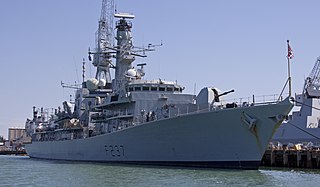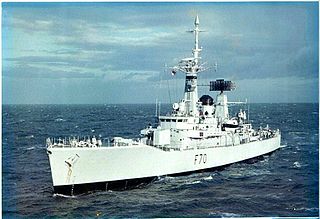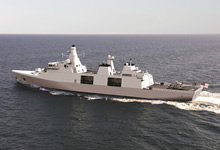Related Research Articles

Surcouf (F711) is a La Fayette-class frigate of the French Navy. Construction began at Lorient Naval Dockyard on 6 July 1992, launched 3 July 1993, and the ship was commissioned May 1996. Since entering service, Surcouf has taken part in numerous missions, notably in Operation Antilope, Operation Trident (Kosovo) and Mission Khor Anga in the Djibouti zone.

The Type 23 frigate or Duke class is a class of frigates built for the United Kingdom's Royal Navy. The ships are named after British Dukes, thus leading to the class being commonly known as the Duke class. The first Type 23, HMS Norfolk, was commissioned in 1989, and the sixteenth, HMS St Albans was commissioned in June 2002. They form the core of the Royal Navy's destroyer and frigate fleet and serve alongside the Type 45 destroyers. They were designed for anti-submarine warfare, but have been used for a range of uses. Ten Type 23 frigates remain in service with the Royal Navy, with three vessels having been sold to the Chilean Navy, and one being retired in 2021, and two being retired in 2023.

The Type 45 destroyer, also known as the D or Daring class, is a class of six guided-missile destroyers built for the United Kingdom's Royal Navy in the early 21st century. The class is primarily designed for anti-aircraft and anti-missile warfare and is built around the PAAMS air-defence system using the SAMPSON Active electronically scanned array (AESA) and the S1850M long-range radars. The first three destroyers were assembled by BAE Systems Surface Fleet Solutions from partially prefabricated "blocks" built at different shipyards; the remaining three were built by BAE Systems Maritime – Naval Ships. The first ship in the Daring class, HMS Daring, was launched on 1 February 2006 and commissioned on 23 July 2009.

HMS Iron Duke is a Type 23 frigate of the Royal Navy, and the third ship to bear the name.

HMS Westminster is a Type 23 frigate of the Royal Navy, and the second ship to bear the name. She was launched on 4 February 1992 and named for the Dukedom of Westminster.

HMS Northumberland is a Type 23 frigate of the Royal Navy. She is named after the Duke of Northumberland. She is the eighth RN ship to bear the name since the first 70-gun ship of the line in 1679, and the ninth in the class of Type 23 frigates. She is based at Devonport and is part of the Devonport Flotilla.

The Leander-class, or Type 12I (Improved) frigates, comprising twenty-six vessels, was among the most numerous and long-lived classes of frigate in the Royal Navy's modern history. The class was built in three batches between 1959 and 1973. It had an unusually high public profile, due to the popular BBC television drama series Warship. The Leander silhouette became synonymous with the Royal Navy through the 1960s until the 1980s.

HMS Dido was a Royal Navy (RN) Leander-class frigate. Entering service in 1961, Dido was involved in the Indonesia–Malaysia confrontation, served with NATO's Standing Naval Force Atlantic on several occasions, and was one of the frigates used for the filming of the drama series Warship.

HMS Cleopatra (F28) was a Leander-class frigate of the Royal Navy (RN). Cleopatra was built at HMNB Devonport. She was launched on 21 March 1964, commissioned on 1 March 1966 and decommissioned on 31 January 1992.
HMS Phoebe (F42) was a Leander-class frigate of the Royal Navy (RN). She was, like the rest of her class, named after a figure of mythology. Built by Alexander Stephen and Sons on the River Clyde, she was launched on 19 December 1964 and commissioned on 15 May 1966.

HMS Matapan (D43) was a later or 1943 Battle-class fleet destroyer of the Royal Navy (RN). She was named after the Battle of Cape Matapan between the Royal Navy and the Regia Marina, which ended in a decisive victory for the RN force, resulting in the destruction of three cruisers and two destroyers of the Italian Navy and was a heavy blow to the Italians. So far, she has been the only ship of the Royal Navy to bear that name.

The Type 26 frigate, also known as City-class frigate, is a class of frigates being built for the United Kingdom's Royal Navy, with variants also being built for the Australian and Canadian navies. The programme, known as the Global Combat Ship, was launched by the British Ministry of Defence to partially replace the navy's thirteen Type 23 frigates, and for export. Its primary role is to conduct advanced anti-submarine warfare missions while supporting air defence and general purpose operations. The type is the first naval platform shared between Australia, Canada and the United Kingdom since the pre-Second World War Tribal-class destroyer.

The Formidable-class multi-role stealth frigates are multi-mission derivatives of the French Navy's La Fayette-class frigate with the Republic of Singapore Navy. The six ships form the First Flotilla of the Navy.
Thales Underwater Systems or TUS is a subsidiary of the French defense electronics specialist Thales Group. It was created in 2001 and belongs to its naval division. It specializes in the development and manufacturing of sonar systems for submarines, surface warships and aircraft, as well as communications masts and systems for submarines. Its headquarters are located in Sophia Antipolis, France.

The Brahmaputra-class frigates are guided-missile frigates of the Indian Navy, designed and built in India. They are an enhancement of the Godavari class, with a displacement of 3850 tons and a length of 126 metres (413 ft). Although of similar hull and dimension, internally, the Brahmaputra and Godavari classes have different configurations, armaments and capabilities. 3 ships of this class serve in the Indian Navy.

A towed array sonar is a system of hydrophones towed behind a submarine or a surface ship on a cable. Trailing the hydrophones behind the vessel, on a cable that can be kilometers long, keeps the array's sensors away from the ship's own noise sources, greatly improving its signal-to-noise ratio, and hence the effectiveness of detecting and tracking faint contacts, such as quiet, low noise-emitting submarine threats, or seismic signals.
Sonar 2076 is a submarine sonar detection system designed by Thales for the Royal Navy.

The Type 31 frigate, also known as the Inspiration class, and formerly known as the Type 31e frigate or General Purpose Frigate (GPF), is a class of five frigates being built for the United Kingdom's Royal Navy, with variants also being built for the Indonesian and Polish navies. The Type 31 is intended to enter service in the 2020s alongside the eight submarine-hunting Type 26 frigate and will replace the five general-purpose Type 23 frigates. The Type 31 is part of the British government's "National Shipbuilding Strategy".
The Daegu-class frigate is a class of guided missile frigates of the Republic of Korea Navy (ROKN). The Daegu class is based on the preceding Incheon class, and has otherwise been referred to as the Incheon class batch II, or FFG-II. Eight Daegu-class ships are planned, with the final goal of 20–22 frigates in the ROKN. The Daegu-class frigates are to be built by Daewoo Shipbuilding & Marine Engineering (DSME) and Hyundai Heavy Industries.

Amiral Ronarc'h (D660) is the lead ship of Frégate de défense et d'intervention of the French Navy.
References
- 1 2 "CAPTAS Family". Thales Group. Retrieved 14 April 2023.
- ↑ "'Eyes and ears' contract keeps ships and submarines on the lookout" (PDF). Desider. No. 62. July 2013. p. 36. Archived (PDF) from the original on 2 November 2019. Retrieved 14 January 2023.
- ↑ "Royal Navy's latest warships to be equipped with Thales anti-submarine warfare capability". Thales Group. Retrieved 14 April 2023.
- ↑ Sweetman, Bill (15 October 2012). "Low Risk, Flexibility Drive Type 26 Design". Aviation Week & Space Technology. Archived from the original on 13 October 2013. Retrieved 24 October 2021.
- ↑ Scott, Richard (14 January 2023). "Thales Started Production of CAPTAS-4 Sonar for US Navy". Naval News. Retrieved 14 April 2023.
- ↑ HMS Sutherlands sonar impresses on first major test, thalesgroup.com, 2010 [ dead link ]
- ↑ Exercise Auriga, defpro.com Archived July 14, 2010, at the Wayback Machine
- ↑ "UK Spearhead plans accelerated capability insertion for Sonar 2087". Janes.com. Retrieved 14 January 2023.
- ↑ Allison, George (25 October 2022). "Royal Navy looking to quickly upgrade sonar on frigates" . Retrieved 15 March 2023.
